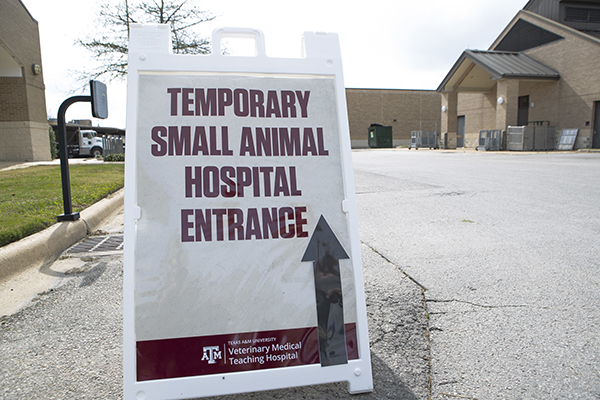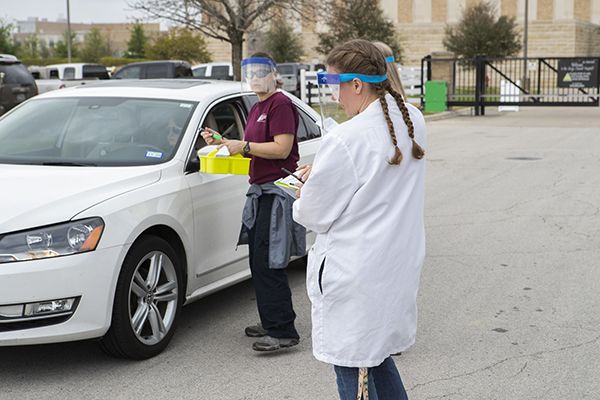COVID-19 Update, FAQs As VMTH Continues Operation During Shelter-In-Place
Story by Aubrey Bloom, CVMBS Communications
4/21/2020 Texas A&M VMTH Curbside Admission, Discharge Update

As the federal, state, and local procedures continue to evolve in response to the COVID-19 pandemic, the Texas A&M College of Veterinary Medicine & Biomedical Sciences’ (CVM) Veterinary Medical Teaching Hospital (VMTH) is dedicated to continuing to provide the highest level of care to our patients and is offering the answers to some frequently asked questions:
Is the hospital open?
Yes. Even though Brazos County is currently under a shelter-in-place order, the Texas A&M Veterinary Medical Teaching Hospital (VMTH) is considered an essential service and is still open for urgent and emergent cases. For questions about the Small Animal Hospital (SAH), please call (979) 845-2351. For the Large Animal Hospital, please call (979) 845-3541.
Do I still go to the same place?
The parking lot in front of the Small Animal Hospital (SAH) is closed, and all traffic should enter via Veterinary Way from Raymond Stotzer Parkway. Upon entering, a station has been set up where clients will be asked some basic screening questions and then will be instructed on where to proceed based on their answers. See our video on the VMTH’s drive-through services here.
What are the changes to the normal procedures?
In an effort to ensure the safety of clients, their animals, and the staff inside the hospital, a number of changes have been made in recent weeks. The most noticeable are that clients will no longer leave their cars, and that the VMTH is currently not performing elective procedures.
If I’m potentially sick with COVID-19, can my pet spread it to other people?

Dr. Wesley Bissett, director of the Veterinary Emergency Team, says, “At this point, what we know right now is that animals are not involved in the disease transmission cycle as something that can support viral infection and replication, but what you do have to worry about is what virus may be on their coat.
The solution to that is pretty straightforward, and that is that the animal needs to be bathed with soap.
But when you’re bathing your pet, you need to take some basic protections. You need to wear gloves. You need to have something on that’s going to keep you from getting wet and making direct contact with the animal. You also need to keep the water pressure low as you’re getting the animal wet and then rinsing.
But after that, again, from everything we know right now, that animal is safe. It’s not going to contribute to the disease. So, if you’re concerned about that, arrange for that type of bath to take place and then that animal should be safe in the event that you need to have one of your loved ones provide the care that it needs, so you don’t have to worry about that while you’re recovering from illness.”
Is the VMTH doing any telemedicine, or are there ways I can communicate with a veterinarian from my home?
The Small Animal Hospital is expanding its use of its telemedicine portal VirtualVet for rechecks and other services to minimize trips to the hospital. For information on VirtualVet availability, clients can email virtualvets@cvm.tamu.edu or call 979-845-2351.
How is the VMTH handling personal protective equipment?
We are working with the Texas Division of Emergency Management (TDEM) to help our colleagues in human medicine to access personal protective equipment.
###
For more information about the Texas A&M College of Veterinary Medicine & Biomedical Sciences, please visit our website at vetmed.tamu.edu or join us on Facebook, Instagram, and Twitter.
Contact Information: Jennifer Gauntt, Director of CVM Communications, Texas A&M College of Veterinary Medicine & Biomedical Sciences; jgauntt@cvm.tamu.edu; 979-862-4216


